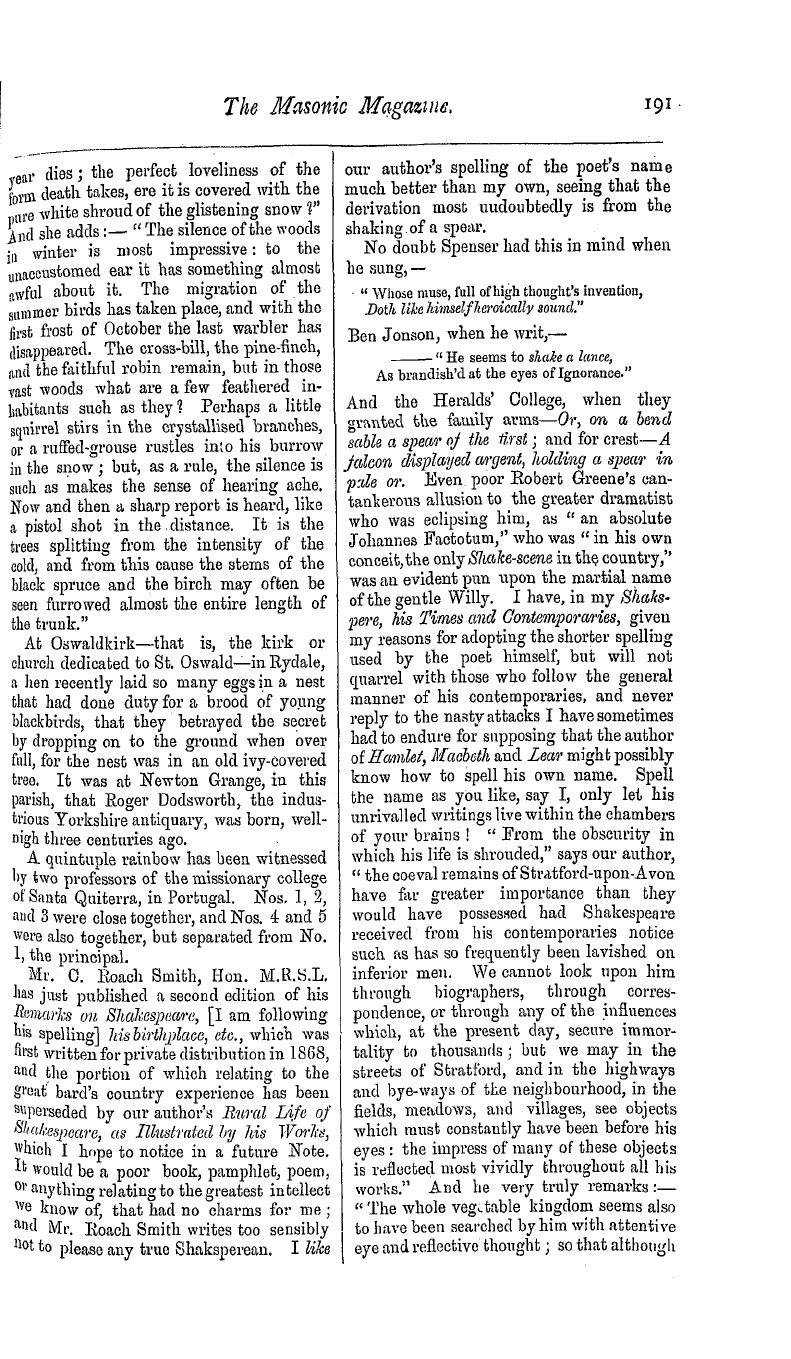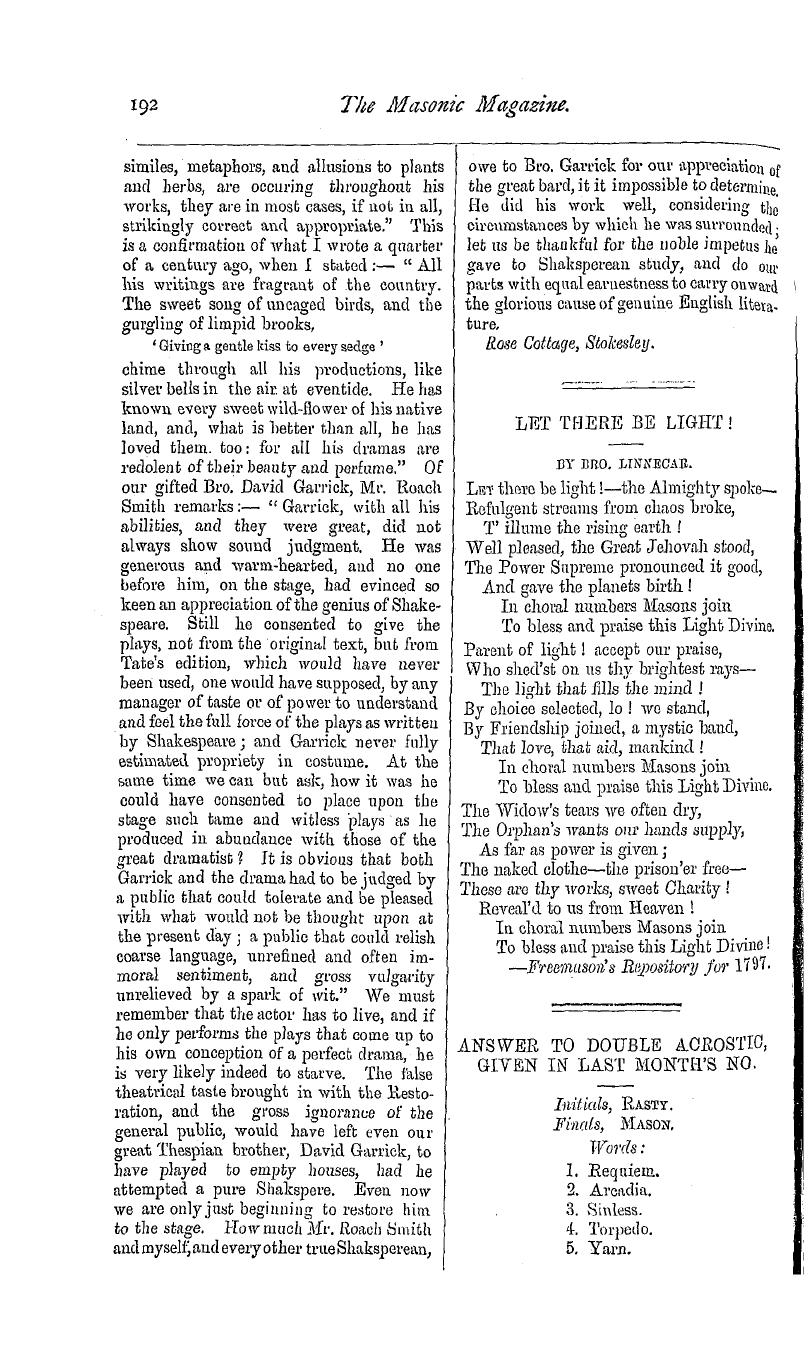Note: This text has been automatically extracted via Optical Character Recognition (OCR) software.
Objects, Advantages, And Pleasures Of Science.
lias been ascertained by observation , and found to agree precisely with the results of calculation . Thus , the planets move in ovals , from gravity , the power that attracts them towards the Sun , combined with the original impulse they receive forwards ;
and the disturbing forces are continually varying the course of the curves or ovals , making them bulge out in . the middle , as it were , on the sides , though in a very small proportion to the whole length of the ellipse . The oval thus bulgingits
, breadth increases by a very small quantity yearly and daily ; and after a certain large number of years , the bulging becomes as great as it ever can be : then the alteration takes a contrary direction , and the curve gradually flattens as it has
bulged ; till , in the same number of years which it took to bulge , it becomes as flat as it ever can be , and then it begins to bulge , and so on for ever . And so , too , of every other disturbance and irregularity in the system : what at
first appears to be some departure from the rule , when more fully examined , turns out to be only a consequence of it , or the result of a more general arrangement
springing from the principle of Gravitation ; an arrangement of which the rule itself , and the apparent or supposed exception , both form parts . The power of Gravitation , which thus regulates the whole system of the universeis found to rule each member or
, branch of it separately . Thus , it is demonstrated that the figure both of our Earth and of such of the other bodies as have a spinning motion round their axis , is determined by gravitation combined with that motion : they are all flattened
towards the ends of the axis they spin upon , and bulge out towards the middle . The great discoverer of the principle on which all these truths rest , Sir Isaac Newton , certainly by far the most extraordinary man that ever lived , concluded ,
"y reasoning upon the nature of motion aild matter , that this flattening must take place in our globe ; everyone before his time had believed the Earth to be a perfect sphere or globe , chiefly from observing the round shadow which it casts ° n the moon in eclipses ; and it was many years after his death that the accuracy of " opinion was proved by measurements
on the Earth ' s surface , and by the different weight and attraction of bodies at the equator , whore it bulges , and at the poles , where it is flattened . The improvement of telescopes has enabled us to ascertain the same fact with respect to the planets Jupiter and Saturn .
Beside unfolding the general laws which regulate the motions and figures of the heavenly bodies forming our Solar System , Astronomy consists in calculations of the places , times , and eclipses of those bodies , and their moons or satellites ( from a Latin
word , signifying an attendant ) , and in observations of the Fixed Stars , which are innumerable assemblages of bodies , not moving round the Sun as our Earth and the other p lanets do , nor receiving the light they shine with from his li ght ; but
shining as the Sun does with alight of its own , and placed to all appearance , immoveable , at immense distances from our world , that is , from our Solar System .
Each of them is probably the Sun of some other system like our own , composed of planets and their moons or satellites ; but so extremely distant from us , that they are all seen by us like one point of faint light , as you see two lamps , placed a few inches asunderonly like onewhen you
, , view them a great way off . The number of the Fixed Stars is prodigious , even to the naked eye they are very numerous , about 3000 being thus visible ; but when the heavens are viewed through the telescope , stars become visible in numbers wholly
incalculable : 2000 are discovered in one of the small collections of a few visible stars called Constellations ; nay , what appears to the naked eye only a light cloud , as the Milky Way , when viewed through the telescope , proves to be an assemblage of
innumerable Fixed Stars , each of them in all likelihood a sun and a system like the rest , though at an immeasurable distance from ours .
The size , motions , and distances of the heavenly bodies are such as to exceed the power of ordinary imagination , from any comparison with the smaller things we see around us . The Earth's diameter is nearly 8000 miles ; but the Sun ' s is about 850 , 000 miles , and the bulk of the Sun is about 1 , 200 , 000 times greater than that of the Earth . The planet Jupiter , which looks like a mere speck , from his vast dis-
Note: This text has been automatically extracted via Optical Character Recognition (OCR) software.
Objects, Advantages, And Pleasures Of Science.
lias been ascertained by observation , and found to agree precisely with the results of calculation . Thus , the planets move in ovals , from gravity , the power that attracts them towards the Sun , combined with the original impulse they receive forwards ;
and the disturbing forces are continually varying the course of the curves or ovals , making them bulge out in . the middle , as it were , on the sides , though in a very small proportion to the whole length of the ellipse . The oval thus bulgingits
, breadth increases by a very small quantity yearly and daily ; and after a certain large number of years , the bulging becomes as great as it ever can be : then the alteration takes a contrary direction , and the curve gradually flattens as it has
bulged ; till , in the same number of years which it took to bulge , it becomes as flat as it ever can be , and then it begins to bulge , and so on for ever . And so , too , of every other disturbance and irregularity in the system : what at
first appears to be some departure from the rule , when more fully examined , turns out to be only a consequence of it , or the result of a more general arrangement
springing from the principle of Gravitation ; an arrangement of which the rule itself , and the apparent or supposed exception , both form parts . The power of Gravitation , which thus regulates the whole system of the universeis found to rule each member or
, branch of it separately . Thus , it is demonstrated that the figure both of our Earth and of such of the other bodies as have a spinning motion round their axis , is determined by gravitation combined with that motion : they are all flattened
towards the ends of the axis they spin upon , and bulge out towards the middle . The great discoverer of the principle on which all these truths rest , Sir Isaac Newton , certainly by far the most extraordinary man that ever lived , concluded ,
"y reasoning upon the nature of motion aild matter , that this flattening must take place in our globe ; everyone before his time had believed the Earth to be a perfect sphere or globe , chiefly from observing the round shadow which it casts ° n the moon in eclipses ; and it was many years after his death that the accuracy of " opinion was proved by measurements
on the Earth ' s surface , and by the different weight and attraction of bodies at the equator , whore it bulges , and at the poles , where it is flattened . The improvement of telescopes has enabled us to ascertain the same fact with respect to the planets Jupiter and Saturn .
Beside unfolding the general laws which regulate the motions and figures of the heavenly bodies forming our Solar System , Astronomy consists in calculations of the places , times , and eclipses of those bodies , and their moons or satellites ( from a Latin
word , signifying an attendant ) , and in observations of the Fixed Stars , which are innumerable assemblages of bodies , not moving round the Sun as our Earth and the other p lanets do , nor receiving the light they shine with from his li ght ; but
shining as the Sun does with alight of its own , and placed to all appearance , immoveable , at immense distances from our world , that is , from our Solar System .
Each of them is probably the Sun of some other system like our own , composed of planets and their moons or satellites ; but so extremely distant from us , that they are all seen by us like one point of faint light , as you see two lamps , placed a few inches asunderonly like onewhen you
, , view them a great way off . The number of the Fixed Stars is prodigious , even to the naked eye they are very numerous , about 3000 being thus visible ; but when the heavens are viewed through the telescope , stars become visible in numbers wholly
incalculable : 2000 are discovered in one of the small collections of a few visible stars called Constellations ; nay , what appears to the naked eye only a light cloud , as the Milky Way , when viewed through the telescope , proves to be an assemblage of
innumerable Fixed Stars , each of them in all likelihood a sun and a system like the rest , though at an immeasurable distance from ours .
The size , motions , and distances of the heavenly bodies are such as to exceed the power of ordinary imagination , from any comparison with the smaller things we see around us . The Earth's diameter is nearly 8000 miles ; but the Sun ' s is about 850 , 000 miles , and the bulk of the Sun is about 1 , 200 , 000 times greater than that of the Earth . The planet Jupiter , which looks like a mere speck , from his vast dis-
















































